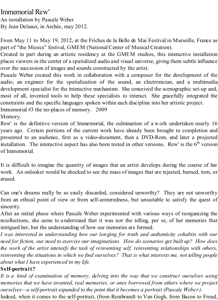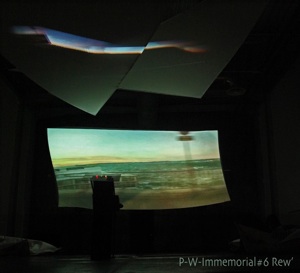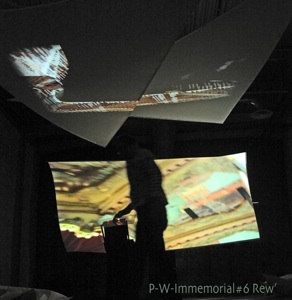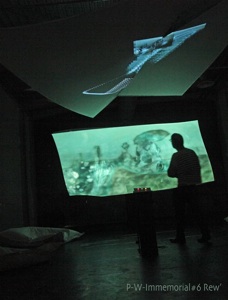Immemorial Rew'
An installation by Pascale Weber
By Jean Delsaux, in Archée, may 2012.
From May 11 to May 19, 2012, at the Friches de la Belle de Mai Festival in Marseille, France as part of "the Musics” festival, GMEM (National Center of Musical Creation).
Created in part during an artistic residency at the GMEM studios, this interactive installation places viewers in the center of a spatialized audio and visual universe, giving them subtle influence over the succession of images and sounds constructed by the artist.
Pascale Weber created this work in collaboration with a composer for the development of the audio, an engineer for the spatialization of the sound, an electronician, and a multimedia development specialist for the interactive mechanism. She conceived the scenographic set-up and, most of all, invented tools to help these specialists to interact. She gracefully integrated the constraints and the specific languages spoken within each discipline into her artistic project.
Immemorial #3 the no-places of memory. 2009
Memory.
Rew' is the definitive version of Immemorial, the culmination of a work undertaken nearly 16 years ago. Certain portions of the current work have already been brought to completion and presented to an audience, first as a video-document, then a DVD-Rom, and later a projected installation. The interactive aspect has also been tested in other versions. Rew' is the 6th version of Immemorial.
It is difficult to imagine the quantity of images that an artist develops during the course of her work. An onlooker would be shocked to see the mass of images that are rejected, burned, torn, or erased.
Can one's dreams really be so easily discarded, considered unworthy? They are not unworthy from an ethical point of view or from self-centeredness, but unsuitable to satisfy the quest of sincerity.
After an initial phase where Pascale Weber experimented with various ways of reorganizing the recollections, she came to understand that it was not the telling, per se, of her memories that intrigued her, but the understanding of how our memories are formed.
I was interested in understanding how our longing for truth and authenticity cohabits with our need for fiction, our need to exercise our imaginations. How do scenarios get built up? How does the work of the artist intensify the task of reinventing self, reinventing relationships with others, reinventing the situations in which we find ourselves? That is what interests me, not telling people about what I have experienced in my life.
Self-portrait?
It is a kind of examination of memory, delving into the way that we construct ourselves using memories that we have invented, real memories, or ones borrowed from others where we project ourselves—a self-portrait expanded to the point that it becomes a portrait (Pascale Weber).
Indeed, when it comes to the self-portrait, (from Rembrandt to Van Gogh, from Bacon to Freud, Sherman, or Coplans) it seems that the repetition of the self-portrait eventually raises it beyond narcissistic notions, beyond self-centeredness. Because it is no longer simply the reproduction of a face, it becomes an entirely different entity—in which the viewer sees himself and can feel empathy. And that is exactly the essence of Immemorial. The memories put forth by Pascale Weber, whether her own or those of the people interviewed (revealed in various ways: evoked, reconstituted, invented, told by others, or elicited through photographs) trigger our own memories. Rather than drawing attention to the presentation of a narrative, something intimate is summoned from our memories which is ours alone.
Separating, assembling.
Pascale Weber recalls the time when she was a painter, how she came to video through photography and movement, how she approaches her themes by collecting then organizing various elements and information. She was, however, discouraged by the linear nature of this type of framework, and like the previous installation, chose instead to separate the audio and the image. This allowed her to deal with each on its own terms. She even separated the individual images from each other, as will be described below.
The text in italics are quotes from a recent interview with Pascale Weber.
There are two unconventionally curved screens. The first is roughly rectangular and faces the viewer; the other is made of two triangular veils and billows in the wind, floating horizontally above the viewer. Eight speakers surround the area, delimiting an audio environment who's very nature is akin to musical composition, who's essence parallels the changing nature of this space.
I left behind the audiovisual object to enter a realm that I can no longer describe, because if you are not there, in the midst of the set-up, the thing has no existence. Rew' is a film that has become an environment.
The “apparatus” is a truly complex object where its components are concerned. This is not so in the way is it perceived by viewer, for it is a space sufficient to itself. Viewers naturally find their place, either at the central control desk or seated in the chairs. What then is the message of this non-object, this “film become environment”? And by what means?
The viewer enters into this zone and receives various kinds of stimuli, visual and audio.
There are two video projections. One of the 25 predefined film clips is projected on the central screen: “My Mother's Age”, “My Father's Eye”, “Places of my Childhood”, “Olfactory Memories” etc. Once the theme has been chosen, Weber goes about collecting as much information concerning the theme as possible. In the street she collects everything that might evoke “the eye”, for example, be it directly or indirectly. For “My Father's Eye” there is the color of his eyes, their clarity, the exclusiveness of that look, the violent feelings toward anyone who interferes with that exclusivity. She films lighting, textures, silhouettes, anything that draws her attention as she wanders. There are no blueprints, no scenarios, just ambiances, sensations, and materials. It is in the same way that she collects sounds, noises, and voices.
Audio trajectory (preparatory sketch)
The “Cloud” of sound which falls vertically, but non-uniformly (with 3-5 different audio ranges) the sound bursts out, suspended, ready to explode (but it detonates only very occasionally). A meteorological conception of ambient noise.
Collaboration, foreign dialogs.
In the studio with Lucien Bertolina, musician, composer and sound engineer, these “collections” are organized and shaped. Weber assesses the silence, emptiness, and pauses. Then, working with Charles Bascou, engineer and developer at the GMEM, the sound data are reworked to produce the spatial aspect of the now structured sounds.
She draws trajectories, almost painting them, creating a sort of sheet music written in braille as a tool to facilitate the dialog between the blind and the deaf. One partner is blind to the visual plasticity of the work and the other is deaf to the technical language of the engineer. Both will attempt the curious task of understanding each other's language, like the bilingual dialogs in a Jarmush film, where neither of the characters understands the language of the other. This kind of intermediation is a constant in creative pursuits and in modern research due to the porosity of the disciplines—the blurring of the borders separating different fields of thought.
All of these things intermingle here: the scripting and sculpting of the sound, the dialog with silence, the rhythm and modelization of the sound in 3D with the engineer, its placement and movement in the surroundings, immersive sculpture allying time and space, the sensuality of the materials, different timbres, movement, perception through a nearly tactile sound, palpation, breath, the holding of breath.
Development, composition, organization.
Lastly she creates the films—films which hint at but don't tell, show movement but don't leave traces. Each soundtrack becomes part of a collection of audio and visual trajectories. These trajectories come together to form a limited but significant number of combinations.
The sound is not in sync with the films—when they are played we see images or hints of images alternating with a black screen. Sometimes there is only the voice-over, and the only thing that appears on the screen is the English translation as a subtitle.
Each film has three spatialized soundtracks, one of which will be set off. Each soundtrack has three possible sound paths.
On the concave veils overhead, we see a “tunnel” of images made up of the successive frames of the film, leaving tracks across the screen as it circulates throughout the projection zone.
The “Tunnel”
Interactivity.
Each spectator may: change to another film, switch the soundtrack, or change the speed of the images (25, 10 or 1 frame/second). Pascale Weber's technique of pausing the images evokes Piotr Kowalski's Time Machine: it challenges the meaning of the viewer's own images and it manifests the will to understand what they have to teach us about ourselves. It is a way of individually experimenting with imagination and memory, a way of disassembling memories and starting from zero. Pascale Weber separates these images that give the illusion of movement and they pass one-by-one. This places us at the fissure between the sound and the image, at the gap between the screens, the images, and the sounds. She lets us intervene as the events unfold and permits interruptions to the predictable linearity. In doing so, she allows something more than a narrative to surface.
And so we work on the time of an image. At this instant, we can enter the film. We enter also into time because we are reflecting on our own time, we are experiencing it. I leave room for the spectator to act, so that he can make the space his own, or even circumvent the system. It is also important to make room for ennui, for emptiness, for silence.
Audio Composition.
For her audio compositions, Pascale Weber met with musicians and oriented them precisely. She asked them to improvise a creation that evoked ambiances which she described in detail. Working with an accordion player, for example, she described memories of a little girl getting her hair braided. Miming, she asked, “Can you picture it? They take your hair and pull, the comb penetrates your skull, parts your skull in two... they take those tendrils at the base of your neck, and they pull, and they keep braiding...” As she speaks, the musician produces a prolonged sound, a sound which drags on, a caustic sound that assails the ear, yet is in harmony with what she described. It's not exactly what you would call a melody.
As for melody, I went about it through song. Melody is akin to narrative. There is a logical continuity which parallels that of narrative and narrative structure. The chorus has something haunting which is repeated, a musical phrase that reveals something other than technical skill... there is something just under the surface of the voice that takes us beyond the story line. It is a melody which takes us back to childhood.
In tearing apart the basic elements of her work (the sound, music, audio trajectories, images, text, frames of the film, the interactivity, and the space) it is up to the viewer to put them back together, organizing them around his own present body, his listening ear, and the perception that he brings to the work. The different building blocks have been fashioned to work together and to form a whole, reaffirming Duchamp's assertion that a piece is created by the spectator. The voice is one of these essential building blocks:
It is through voice that I approached the concept of sound. I really delved deeply into the concept of voice. You have both the emotional charge contained in voice, as well as the narrative that is being told. In Immemorial I went even farther: I took the medium of voice and created a sound artifact.
Emotion, Reason.
In this installation (as has surely been made obvious) you won't find a clean separation between sound and image, but rather a matter that to some is perceived on a sensory level as sounds, sound blocks, and visuals. To others it is mainly perceived on a narrative level in a rational way through voice, decipherable images, and separated frames which reveal the flow of space and time as a series of “mobile cross-sections”. The very spatiality speaks physically to the viewer; the story is convoluted and fleeting, continuously remixed and reshaped.
The “tunnel” of images on the ceiling transforms the succession of images into a chronophotograph-in-motion. It attracts the eye, yet doesn't detract from the viewer's absorption—or lack of—in the story.
The images work on many levels. They may be experienced like the TV in the corner of the living room that, despite perhaps being in the middle of a fascinating conversation, unfailingly draws the eye. They can also function as part of a plastic yet very organized entity.
Using right brain and left brain, reason and emotion, the stimuli in Rew' are assembled and form combinations not according to the technical programming, nor their visual or audio nature, but according to whether they are labeled as sensory or as narrative information. Each element is capable of belonging to either category. Not surprisingly, Pascale Weber has ongoing exchanges with cognitive scientists and cognitive psychologists, notably Alain Berthoz and Pascale Piolino, and has collaborated with them on research projects. To allow the viewer to experience the full force of the installation, scientific data and theories are deliberately absent from the work. Yet it is unarguable that her collaboration with these scientists has enriched Weber's conception, helping give the issues concerning memory a concrete yet pliant physical form.
Immemorial-Rew' will be presented at “Friches de la Belle de Mai” in Marseille, from May 11- 19. Immemorial-Rew' is the recipient of the Pierre Schaeffer Award at the SCAM (Civil Society of Multimedia Authors).
Jean Delsaux
Senior Lecturer, director of the LEEE (Laboratory of Esthetic Experiments with Space) at the University of Clermont I
Immemorial-Rew' was created in collaboration with:
Charles Bascou, sound engineer, development of the audio trajectories.
Jérôme Decque, audio recording.
Lucien Bertolina, musician, sound editing.
Luccio Stiz, multimedia development.
Sylvain Delbard, creation of the interactive mechanism.
Jean Delsaux, artistic and technical advisor.
2 Honorary professor at the College de France where he directs the Laboratory of Physiology, Perception, and Action.
2 Professor at the Université Paris Descartes, member of the University Institute of France, focusing on autobiographic memory.






